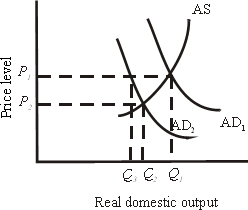 |
| 1 |  | 
An increase in the price level will: |
|  | A) | increase net exports. |
|  | B) | reduce the value of household debt and increase investment. |
|  | C) | increase production costs and reduce short-run aggregate supply. |
|  | D) | reduce the purchasing power of household wealth and reduce consumption. |
|
|
 |
| 2 |  | 
Answer the next question using the following graph:
 <a onClick="window.open('/olcweb/cgi/pluginpop.cgi?it=jpg::::/sites/dl/free/0077337727/883757/ch29_q2.jpg','popWin', 'width=NaN,height=NaN,resizable,scrollbars');" href="#"><img valign="absmiddle" height="16" width="16" border="0" src="/olcweb/styles/shared/linkicons/image.gif"> (20.0K)</a> <a onClick="window.open('/olcweb/cgi/pluginpop.cgi?it=jpg::::/sites/dl/free/0077337727/883757/ch29_q2.jpg','popWin', 'width=NaN,height=NaN,resizable,scrollbars');" href="#"><img valign="absmiddle" height="16" width="16" border="0" src="/olcweb/styles/shared/linkicons/image.gif"> (20.0K)</a>
Refer to the graph. The shift from AD1 to AD2 may have been caused by: |
|  | A) | a reduction in the price level. |
|  | B) | a reduction in aggregate supply. |
|  | C) | a decline in personal taxes. |
|  | D) | a decrease in government spending. |
|
|
 |
| 3 |  | 
Answer the next question using the following graph:
 <a onClick="window.open('/olcweb/cgi/pluginpop.cgi?it=jpg::::/sites/dl/free/0077337727/883757/ch29_q3.jpg','popWin', 'width=NaN,height=NaN,resizable,scrollbars');" href="#"><img valign="absmiddle" height="16" width="16" border="0" src="/olcweb/styles/shared/linkicons/image.gif"> (20.0K)</a> <a onClick="window.open('/olcweb/cgi/pluginpop.cgi?it=jpg::::/sites/dl/free/0077337727/883757/ch29_q3.jpg','popWin', 'width=NaN,height=NaN,resizable,scrollbars');" href="#"><img valign="absmiddle" height="16" width="16" border="0" src="/olcweb/styles/shared/linkicons/image.gif"> (20.0K)</a>
Refer to the graph. Suppose aggregate demand falls from AD1 to AD2. In the short run, this will cause output to: |
|  | A) | fall to Q2 and the price level to P2. |
|  | B) | fall to Q2 but the price level to remain at P1. |
|  | C) | fall to Q3 but the price level to remain at P1. |
|  | D) | remain unchanged but the price level will fall to P2. |
|
|
 |
| 4 |  | 
The short-run aggregate supply curve: |
|  | A) | assumes that wages and salaries fully match any change in the price level. |
|  | B) | is a vertical line located at the full-employment level of output. |
|  | C) | shows the amount of real output supplied at various price levels. |
|  | D) | becomes increasingly flatter as output expands. |
|
|
 |
| 5 |  | 
A leftward shift of the short-run aggregate supply curve would illustrate: |
|  | A) | demand-pull inflation. |
|  | B) | an inflationary gap. |
|  | C) | a positive GDP gap. |
|  | D) | cost-push inflation. |
|
|
 |
| 6 |  | 
At very low levels of output, the short-run aggregate supply curve is relatively: |
|  | A) | flat, because firms are reluctant to give their current workers raises when output is so low. |
|  | B) | flat, because firms can expand output with relatively little increase in per-unit production costs. |
|  | C) | steep, because increasing output will cause relative large increases in per-unit production costs. |
|  | D) | steep, because increasing output will cause aggregate demand to increase. |
|
|
 |
| 7 |  | 
The aggregate demand curve slopes downward to the right: |
|  | A) | because a lower domestic price level reduces net exports. |
|  | B) | because of the income and substitution effects of lower prices. |
|  | C) | at low prices, but not at high prices. |
|  | D) | because a lower price level reduces the demand for money, which lowers the interest rate and increases desired investment. |
|
|
 |
| 8 |  | 
An increase in the incomes of U.S. trading partners would shift the U.S.: |
|  | A) | aggregate demand curve to the right. |
|  | B) | aggregate demand curve to the left. |
|  | C) | aggregate supply curve to the right. |
|  | D) | aggregate supply curve to the left. |
|
|
 |
| 9 |  | 
Higher prices of imported resources will: |
|  | A) | move the economy downward and to the right along the aggregate demand curve. |
|  | B) | make the aggregate demand curve steeper. |
|  | C) | shift the aggregate supply curve to the left. |
|  | D) | shift the aggregate demand curve to the left. |
|
|
 |
| 10 |  | 
In the short run, a reduction in aggregate demand is: |
|  | A) | likely to cause a reduction in the price level. |
|  | B) | unlikely to cause a reduction in the price level because of the interest rate effect. |
|  | C) | unlikely to cause a reduction in the price level because of menu costs and efficiency wages. |
|  | D) | likely to cause a reduction in aggregate supply. |
|
|

